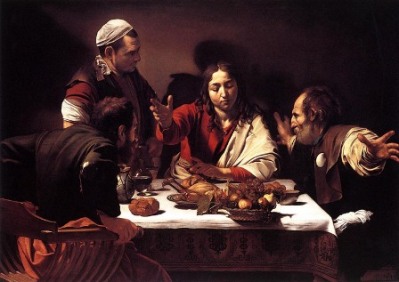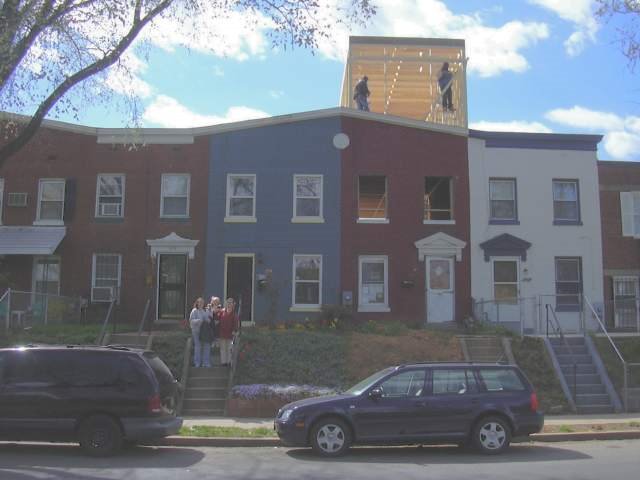The Gospel is long. It’s two full chapters. The deacon and both lecters take turns reading it. (And we started the Mass with another Gospel reading as well.) Many things jump out at me.
First is the woman pouring the expensive oil over the Lord’s head. For some reason I’ve always remembered the line, “The poor you will always have with you,” even quoting it, during my life, most of which has been spent away from the Church. I always thought of it as a realistic sort of assessment of the state of things, that there will always be rich and there will always be poor. And while that’s true, there always will be, in the context of the Gospel here, the point is not that there will always be rich and poor, but that Jesus is facing death, and it’s really hard and frightening. That’s his point. Here’s someone doing something very kind to him. It helps in facing the terror about to happen.
And now I think also about the Kingdom of Heaven, about how it will not include rich and poor, that either such things won’t matter or that the rich will have to pass the camel through the eye of the needle first. And then I think about how most of the world lives on a dollar a day. And how utterly rich I am. But of course I don’t feel rich. Not comparatively, not here in America, not when I live in the neighborhood where I live. I still want so many things; I still want so much stuff.
And then I’ll never make it with my camel through that needle.
Then in today’s Gospel there’s Judas. And this week the National Geographic Society has made some headlines with an ancient work called the Gospel of Judas. And what to make of Judas, eh? On the one hand, Christ himself says in our reading today, “[W]oe to that man by whom the Son of Man is betrayed. It would be better for that man if he had never been born.” And, although not in today’s reading, afterwards Judas immediately regrets his betrayal and hangs himself. But, on the other hand, and the Gospel of Judas apparently speaks to this, is the necessity of Judas, the necessity of a betrayal. Christ has come down from heaven to become the paschal sacrifice; that sacrifice has to be effected. He must somehow be handed over to the authorities. So somebody’s gotta do it.
In the Gospel of St. John, Jesus hands the morsel to Judas and says to him, “What you are going to do, do quickly,” sending him off to do his awful deed. Jesus knows who it is and when he’s doing it. But this Gospel of Judas adds this whole backstory where Jesus reveals all manner of mysteries to Judas. Okay. But in St. John, during this moment with the Lord and Judas, there’s this about Judas: “After he took the morsel, Satan entered him.” So how does that work, Judas as secret mystery of the kingdom guy, but also tool of Satan? How can he be both? I just can’t see how he can. (See the Wikipedia article for more on the whole Cainite heresey.) Apparently the Church fathers who codified the canon couldn’t either.
Then the Passover meal, the Last Supper, where the Lord gives us the Eucharist:
While they were eating,
he took bread, said the blessing,
broke it, and gave it to them, and said,
“Take it; this is my body.”
Then he took a cup, gave thanks, and gave it to them,
and they all drank from it.
He said to them,
“This is my blood of the covenant,
which will be shed for many.
We hear and remember and re-enact these words at every Mass. So in one way they’re so familiar, almost rote. But then today we have them in context, and in such a context. In the hard and the frightening and the terror that’s coming.
And then there’s my man Peter. How he screws up so much, is why I like him so much. Here’s one of his biggest, denying Christ three times. And this makes me think of the recent thing in Afghanistan, with the convert from Islam to Christianity, and the trouble he got into. I was talking to Dawn about it, and just idly wondering what I would do if I were arrested, were facing death because of my faith. And without even having to think too hard about it, I knew immediately what I’d do.
I said that I would lie, of course. Like Bruce getting out of the draft, checking off that he was a communist, a homosexual, whatever. Tell ’em I was a Druid. Tell ’em I was a Muslim. Whatever. Just get me outta here man.
And then I immediately thereafter felt sad. Felt guilty. I mean, here we venerate the saints, the martyrs especially. My beloved St. Agnes, martyred for her faith, for her refusal to renounce her faith, and I without hesitation decide to lie? How awful is that? So I wonder where that comes from. I mentioned earlier, thinking partly about this too, that most of my life has been spent away from the Church. So I’ve developed many ways of doing things and thinking that I have to change. And believe me, lying is the very least of what I’ve done. Although lying is pretty bad, of course. Let’s not minimize it. But other stuff? Yikes. You don’t want to know.
And so anyway, the point is that I’m wanting to not do bad things, to live by certain values from now on. And I think I’m doing pretty well. I mean, I don’t feel like I’ve changed drastically since picking up the faith again. I can still have a beer, watch a movie, say “fuck” too much. All that. And then not steal, not kill, not covet my neighbor’s ass. Go to church. Pray. Those too. And but then in another sense I’ve undergone a profound conversion, giving up on the pride of thinking that I’ve got all the answers, that I’m going to figure it all out on my own, that I can do anything but hang my head and beg for God’s grace and mercy.
And, okay, that’s all great, all well and good. But, at the very least, I would like to think that I would at least consider not renouncing my faith if pressed. I’m not saying I’m ready for sainthood, for martyrdom. But just for a second, maybe, to think about it. Is all I’m saying.
And that I suppose is why I like Peter so much.
And the Lord at Gethsemane is so utterly heartbreaking. St. Mark describes him as troubled, as distressed. He says, “My soul is sorrowful even to death.” He says, “Abba, Father, all things are possible to you. Take this cup away from me … ”
So just for a second, maybe, he thinks … But he knows what he has to do, no matter how hard and frightening it is. “Abba, Father, all things are possible to you. Take this cup away from me, but not what I will but what you will.”
Thy will be done, is our standard prayer. Not my will, Lord, but yours.
And, later, the high priest asks him, “Are you the Christ?” I think of my first marriage, my mother- and father-in-law. They had this sort of Quaker notion, where they thought Jesus was a cool guy, a great philosopher even, but they just didn’t like the whole Christology business. I wasn’t much of anything at the time, just an estranged Catholic I guess, but even then that didn’t make much sense to me. And here the high priest asks, “Are you the Christ?” And Jesus replies, “I am.” And cross-reference here the burning bush in Exodus. Moses asks what he should call him and God says, “This is what you shall tell the Israelites: I AM sent me to you.” Jesus is equating himself with, and declaring that he is, God. There’s your Christology right there, from Jesus himself.
And I’m glad that the responsorial psalm is “My God, my God, why have you abandoned me?” It’s always struck me as such a strange line, such a strange thing for Christ to say. So at least here we see that he at least was quoting scripture, that he was quoting Psalm 22. Although I’m still not sure why he quotes it. I guess because the psalm is itself a cry for help. “[D]o not stay far off,” it says. “[C]ome quickly to help me.” He is in such pain. He is in agony. He’s dying.
At “Jesus gave a loud cry and breathed his last,” we all kneel for a short time, as per the instructions in our little booklet we’ve been given. I’m disappointed though that the short time is so short. It all has been so moving and upsetting. A little quiet prayer time would be nice, but I’m just getting started when everybody heaves back up. Ah well. Later.
Then Joseph of Arimathea bravely gets the Lord taken down and buried. And the women watch over the tomb.
And welcome to Holy Week, folks.



